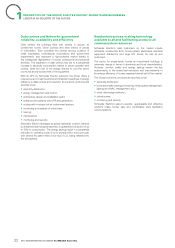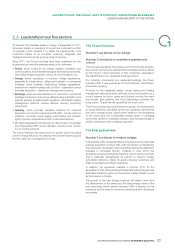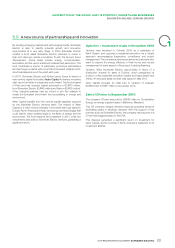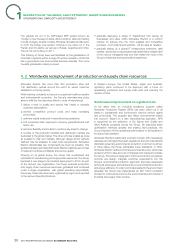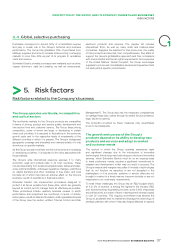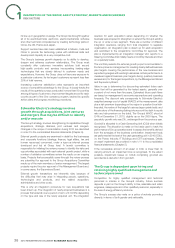APC 2010 Annual Report Download - page 33
Download and view the complete annual report
Please find page 33 of the 2010 APC annual report below. You can navigate through the pages in the report by either clicking on the pages listed below, or by using the keyword search tool below to find specific information within the annual report.
DESCRIPTION OFTHEGROUP, ANDITSSTRATEGY, MARKETS ANDBUSINESSES
1
INNOVATION AND R&D: SERVINGGROWTH
3. 4 Partnerships to accelerate progress
In addition to its innovation and R&D initiatives, Schneider Electric
pursues an active R&D partnership policy with prestigious
institutions, notably Shanghai Jiao Tong University in China; the
MIT Media Lab and Georgia Tech in the United States; the CEA
(Alternative Energies and Atomic Energy Commission), INRIA
(National Institute for IT and Automation Research), École des
Mines ParisTech, Institut National Polytechnique de Grenoble and
Université Joseph Fourier in France; and Monterrey Institute of
Technology in Mexico.
The Group is also involved in numerous collaborative projects
with academic and industrial partners in France and the rest of
Europe, notably in the areas of energy effi ciency and environmental
protection.
Partnerships in energy efficiency programs
HOMES (Homes and buildings for Optimised Management
of Energy and Services) is Europe’s biggest innovation program
focusing on the active energy effi ciency of buildings. Led by
Schneider Electric and supported by OSEO, an agency that
supports entrepreneurship and innovation, it involves a total of 13
companies and research laboratories.
The aim of HOMES is to fi nd a number of coherent solutions to
improve energy management for buildings without reducing
comfort.
Covering both new and existing residential and commercial
buildings, the program’s goal is to produce prototypes ready for
manufacture within two years.
Five initial prototypes were unveiled in September 2010 at the
Intelligent Building Systems exhibition in Paris:
•Roombox, a decentralised and cross-application electric
command and control architecture (Schneider Electric);
•an HVAC (heating, ventilation, air conditioning) emissions
controller, for precise ventilation management and improved
information transmission (CIAT);
•an independently powered wireless sensor, for integration of
all the comfort parameters in a single component (Schneider
Electric and the CEA);
•the eveBIM collaborative software, designed to integrate ideas
on energy effi ciency at every stage in the construction and
management of a building (CSTB);
•the ZigBee and carrier current equipment, to make available to
the living environment an integrated group of products to manage
electrical charges and measure consumption (Schneider Electric
and Watteco).
In addition, testing has been carried out under the program at fi ve
pilot sites since February2010, in conjunction with the FFIE (French
federation of electrical engineers). The aim is to devise a method for
effectively measuring performance for existing buildings, to enable
ways of reducing energy consumption to be identifi ed in each case.
The VELCRI (electric vehicle with integrated fast charger)
program was set up to fi nd a global solution (vehicle and recharging
station) to increasing the availability of electric vehicles, with
three main aims: reducing battery recharging time, developing
a “bidirectional electricity exchange”, and offering services for
vehicle users through communication between the vehicle and the
recharging station. Schneider Electric’s partners in this project are
Renault, Radiall, Johnson Controls Saft, Valeo, EDF, Apojéen, the
CNRS, the CEA, the Institut Telecom, and Eurecom.
Mobility on Demand
Experiments on electric vehicle recharging are also being carried
out in collaboration with MIT as part of the Media Lab’s Mobility on
Demand project.
The aim of EnergeTIC, a project certifi ed by the Minalogic business
cluster, is to design a system that optimises energy use at data
centres, by continually adapting the material confi guration to the
needs of applications. Optimum energy management is achieved
in two ways:
•in reactive mode, which adjusts energy consumption to the
current needs indicated by the IT application, almost in real time;
•in anticipation mode, in which IT projections are used to smooth
energy consumption. The original idea for this mode of operation
was to take advance of the fl exibility of task ordering and the
intrinsic inertia of the installation.
The project will enable potential energy gains to be validated and
quantifi ed by testing on real sites.
The partners involved in the project are: Bull, B&D Eolas, G2ELab,
G-SCOP, UXP and Université Joseph Fourier.
The MIND project’s objective is to improve the productivity of
embedded software, a critical component of “intelligent” products.
Using a component assembly construction approach, this
technology allows for the effi cient development of safe and fl exible
products.
2010 REGISTRATION DOCUMENT SCHNEIDER ELECTRIC 31



